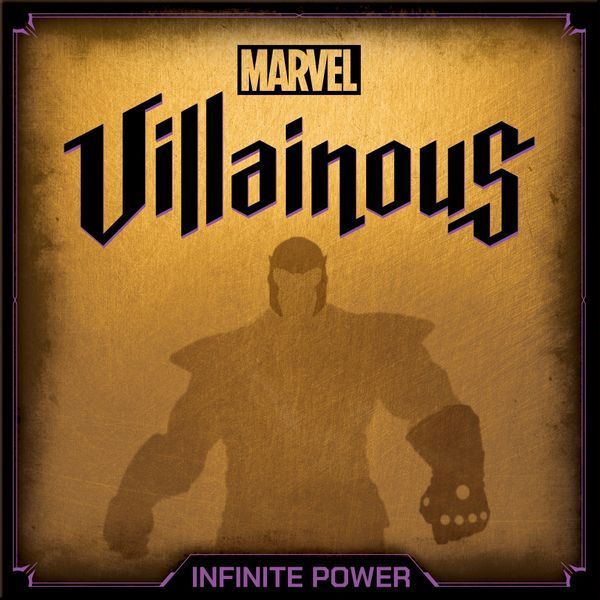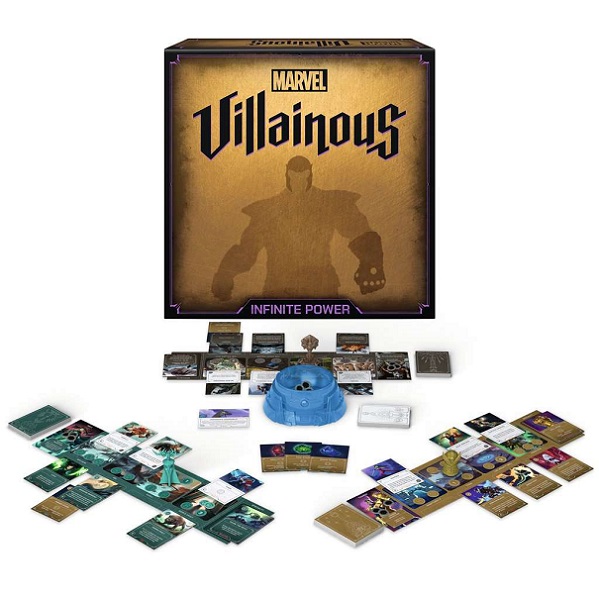Become the Ultimate Super Villain in Marvel Villainous: Infinite Power

Play as Thanos seeking the infinity stones, or Ultron as he brings about destruction. Published by Ravensburger and designed by Prospero Hall, Marvel Villainous: Infinite Power puts you in the shoes of Marvel villains.
As a brand new, standalone Villainous game, Marvel Villainous is more than a retheme. It introduces new rules and game mechanics that pit players against each other as well as the Avengers.
Gameplay
Each player selects a villain and moves that villain’s board in front of themselves. Each board shows four locations, as well as a space for specialty cards. Each villain also comes with their own deck of cards, and you start the game with a hand of four. Each villain will also have their own discard pile for their deck.
During setup, you take the fate deck associated with each villain being played this game and shuffle them into the common fate deck and place this in the center of the table. Depending on which villains are being played there may be one or two additional setup steps — for example, if playing with Thanos, you take the six infinity stone tiles and place them on the table within reach.
On your turn, you start by moving your villain’s pawn from one location on your board to another. Then you may perform actions. You must always move at the start of your turn. Each location shows a series of actions along the top and bottom of it. You may perform each action that is displayed at your current location. If the same action is displayed more than once, you may perform it once for each time it is displayed. During the game, hero cards will sometimes be played to your locations, covering the actions shown at the top of it. When actions are covered by a card, you may not perform them until you get rid of that card. At the end of your turn, you draw back up to a hand of four cards if applicable.
Actions include gaining power tokens, playing a card (most cards also cost a certain number of power tokens in order to play), activating an ability on a card, moving one of your allies from one location on your board to another, vanquishing a card, discarding cards from your hand, or drawing a card from the fate deck.
When playing a card from your hand, there are a number of different types of cards you can play. There are specialty cards, which you place in your specialty area. These cards cannot be removed by an opponent, and will often give you special abilities to use during the game. Allies cards are played along the bottom of your board into any location or to an event from the fate deck. Items are either played along the bottom of your board or must be attached to one of your allies. Items will have different bonuses or effects. You may also play an effect card which will have a one-time ability.
When you draw a fate card, if it is not an event, you may choose which opponent’s board and which location on that board to place it. Certain fate cards will be more powerful against certain villains, but you do not have to choose that villain to play it on. Other than events, fate cards are either heroes or items which attach themselves to heroes, giving them extra abilities. Each hero has a strength value. In order to defeat a hero and discard it from your board, you must have enough of your allies at that hero’s location whose combined strength equals or exceeds the hero’s. You must then use the vanquish action. The hero is then discarded along with any of your allies who were used in the battle.
Events from the fate deck will either be global events which affect all players, or will be targeted events which only affect a specific villain (the card will say which villain). Every event has a negative effect such as making allies more expensive to play. Every event also has a strength value. The event is discarded when enough allies are played to an event with a combined strength value higher or equal to the event’s. Each player who contributed receives a reward as shown on the event card.
Each villain has a separate win condition that you must meet in order to win the game. For example, Thanos must gather the six infinity stones. To do this he must find cards either in his deck or in the fate deck, which will assign the stones to an opponent’s ally. Thanos has the unique ability that he can move his own allies to an opponent’s location where an infinity stone is and then attack the ally. Thanos must then have at least one ally left alive in order to bring the stone back. Interestingly, as long as a stone is at your location, you may use the action displayed on it as you would a regular action. Hela’s win condition, meanwhile, involves attaching soul mark tokens to heroes and collecting them when they are defeated. She must acquire a certain number of soul marks and allies in order to win.

Review
Marvel Villainous plays a lot like Disney Villainous, and could have simply followed the exact same format and still have been a fun game to play. Instead, while quite similar, it adds a few of its own twists to the mechanics that work quite well and ensures it feels like more than a simple retheme.
Combining all the fate decks into one adds an extra element of unpredictability, gives a little more variety to what each player will encounter, and also leads to some interesting choices when you’re playing with three or more players. Since you draw the fate card and then decide where to send it, you are free to adapt your decision to the card drawn and the effects it will have. This is particularly useful as certain fate cards will hurt certain characters more. It also just makes thematic sense that these heroes would be battling all of the villains. In a two-player game, though, you lose a lot of this decision making, and an additional rule for that player count allowing you to draw two cards and choose one might have helped.
The specialties are also intriguing, opening up extra actions or abilities, and providing a permanent boost to your villain as they cannot be defeated or removed by other players.
Events are an interesting new edition to the gameplay, as well. The rewards for completing them can be helpful, and it’s fun having this joint task that all players can work towards, together, while still competing against one another. But there is no scaling for the cost to defeat them across player counts, which means in a two-player game some events can stick around for quite some time.
Like its predecessor, the game does a great job of using the theme to complement the mechanics of the game. Each villain feels really unique, with their own strategies and mechanics that fit well with their stories and themes. Thanos in particular is an interesting villain, as he brings with him a lot of extra player interaction, as you actually have to attack your opponents to retrieve those infinity stones. We liked this increase in player interaction, and in general the game does have a few extra elements of interaction spread throughout. However, the villain goals are a little more complicated than some you’ll find in Disney Villainous, and take a bit to wrap your head around, which definitely increases the game’s learning curve.
There’s always been a bit of luck in the Villainous games, needing to draw exactly the right cards and that’s certainly still the case here. But the different villains provide plenty of intriguing strategic choices, and learning how to master each one continues to be fun and challenging.
The component quality is slightly inferior than that in the Disney Villainous line. The holder for the tokens is significantly flimsier and the player pawns are less solid. Still, the overall quality is quite nice and we you weren’t comparing it to the stellar quality of its predecessor, it’s likely that only the token holder would elicit negative comment.
Marvel is going to be a popular theme that will appeal to plenty of players. The game straddles the line between the comics and the movies. All the villains included are either from the films already out or (in the case of Taskmaster) ones set for release in the near future, and many of the allies and heroes will be familiar to people who know only the movies. However, there’s also plenty of characters, locations, and items that haven’t appeared in the MCU (Marvel Cinematic Universe), and some of the artwork is more reminiscent of the comics as well (Scarlet Witch, for example, is depicted as she appears in the comics rather than the films). A nice balance is struck here that should appeal to a range of Marvel fans.
If you have never played a Villainous game before, this one is definitely a little harder to learn and may not make for a great starting point for casual fans unless it’s for the theme. However, we did like the new elements brought to the gameplay, and even felt that some addressed issues from the previous design, such as lack of player interaction.
Pros: Increased player interaction, new additions to the mechanics, theme designed with both film and comic fans in mind
Cons: Slightly inferior components compared to previous Villainous games, some scaling issues across player counts, a little more difficult to teach and learn
Disclosure: we received a complimentary review copy of this game.







